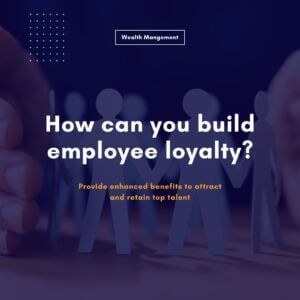Guest post by Matthew Bailey, BAA, Investment Advisor at RBC Dominion Securities, part of our series 10 Key Decisions for Business Owners.

Provide enhanced benefits to attract and retain top talent
As a business owner you know how important it is to recruit, reward and retain your top talent.
It can help ensure business continuity and protect the knowledge you have accumulated within your organization, and it may help you make effective succession planning decisions when the time comes. The loss of a key employee can be very expensive to an organization, so give some thought to how you can motivate key employees and keep them focused on the company’s priorities.
Employer-sponsored savings plans
Employees are increasingly conscious of the necessity to provide for their retirement. Employer-sponsored savings plans are one of the most important aspects of retirement planning and can help you ensure that your employees enjoy a financially secure retirement. Before setting up a retirement plan, discuss the options with your professional legal, tax and/or financial advisors. Here are some of the more common types of retirement plans offered by employers.
Group registered retirement savings plans (Group RRSPs)
Group RRSPs are one way you can encourage your employees to save for retirement throughout their careers. They could be an option even for a small business owner.
These plans operate like regular RRSPs, possibly with additional restrictions, and can be more cost-effective and easier to administer than pension plans.
Registered pension plans (RPPs)
RPPs are employer-sponsored pension plans. In general, employer and employee contributions are tax-deductible and the income earned within the plan grows tax-deferred. Funds accumulating within the plan for individual members are generally locked in by provincial/ territorial or federal legislation. There are two kinds of RPPs:
Defined contribution (DC) and Defined benefit (DB) pension plans
Employees with a DC pension plan choose the investments within their individual plan, and the retirement benefit is based on the value of the investments in the plan when the employee retires. This can be a less costly option for you as an employer than a DB plan and is easier to administer.
In contrast, DB plans guarantee a specific benefit to the employee at retirement, calculated using a formula based on earnings and years of service. DB plans generally specify an age, usually 65, at which employees are expected to start receiving retirement income. As an employer, you face a potentially greater obligation with a DB plan han with a DC plan because you must make the investment decisions and guarantee the employee gets a fixed benefit in retirement. If there are insufficient funds in the plan, you may also be required to top up the plan by making a greater current cash flow commitment to the DB plan than expected. If there is a surplus in the plan, you may have reduced payments.
Business planning quick tip
Financial incentives like enhanced retirement benefits can help you retain your key employees, but don’t forget about non-financial aspects such as career development and work/life balance.
Enhanced retirement benefits
The following options may help you enhance the retirement savings plans of your key employees:
Supplemental executive retirement plans (SERPs)
Limits on registered plan contributions and benefits can leave your higher-income employees with retirement benefits that are inadequate to maintain their standard of living. A SERP may help bridge the gap between the maximum pension available under the company’s RPP and what a higher- income employee would receive were there no maximum. It can also be a way to help you retain your valuable employees and encourage their long- term loyalty.
One of the most common forms of a SERP is the retirement compensation arrangement (RCA). An RCA is a non- registered pension arrangement that can help you provide supplemental pension benefits for key employees.
RCAs have no legislated contribution limits (provided contributions are “reasonable”) and no investment restrictions. Employees may also be able to benefit from certain investment strategies involving life insurance.
Individual Pension Plans (IPPs)
As previously mentioned, an IPP is a DB pension plan.
It can be set up for a business owner but also for key employees to provide for their retirement.
IPPs are typically suited for those who are age 40 or older and earn significant employment income.
Learn from experience
While financial compensation often attracts your key employees, non- financial benefits often help you retain them. Sufficient tools and time to do the job are essential to employee satisfaction, while training and career development help to keep them motivated. Aim to foster a social environment and a sense of team, and demonstrate your commitment by ensuring that work/ life balance can be achieved.
If you lose a key employee, hold an exit interview so you understand the reasons for their departure.Their dissatisfaction may indicate problems among other key employees and may save you from another costly loss.
We can help you assess the advantages of enhanced employee benefits, including RCAs, IPPs, Group RRSPs, and assist you in setting up these plans. Contact Nicole Montminy or Matthew Bailey.
